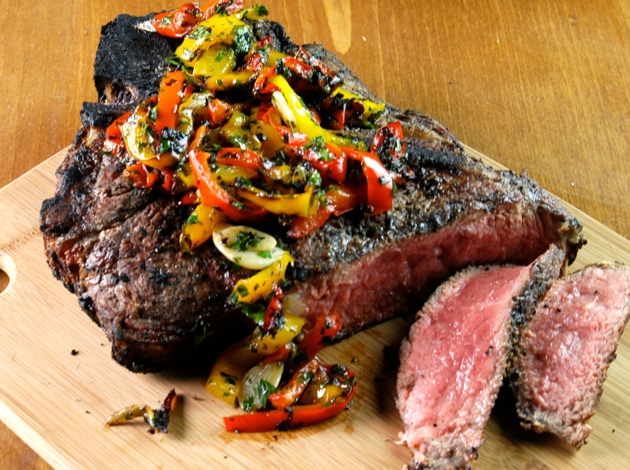Barbecue University™
The 10 Secrets to Grilling a Perfect Steak

Eating a perfectly cooked steak is a transcendent — some would say lascivious — experience for carnivores. There’s that first bite — the outside crusty, salty, and darkly seared; the inside, beefy-tasting, juicy, sanguine, and impossibly tender. But let’s face it: Not even high-end steakhouses get it right all the time. No wonder backyard grillers face raw — and pricy! — steak with trepidation. You’d be surprised how many people know their way around brisket and ribs, but can’t consistently grill a good steak.
Yes, much can go wrong at every stage of the process, from the procurement to the plating. But armed with the 10 strategies below, you should nail a great steak every time.
- Choose the right steak: A Porterhouse is the best of both worlds, consisting of a New York Strip and a filet mignon united by a slender T-shaped bone. Other top cuts include rib eyes, T-bones (a smaller version of a Porterhouse), and new cuts, like the flatiron. Don’t overlook tougher, meatier cuts, like sirloin, hanger steak, skirt steak, and flank steak — just be sure to thinly slice across the grain before serving.
- Keep it in the refrigerator until grilling. This runs contrary to many theories, but no steakhouse worth its salt leaves meat out at room temperature in a hot kitchen.
- Build a 3-zone fire: Use the hot zone for searing, the medium zone for cooking, and have a safety zone where you can move the steaks to dodge any flare-ups.
- When it comes to seasoning, keep it simple: Season generously with coarse salt (kosher or sea) and freshly ground black pepper right before grilling. (The salt helps form a satisfying crust.) Or for a more complex flavor, try my Best of Barbecue steak rub.
- Remember the grill master’s mantra: Keep it hot. Keep it clean. Keep it lubricated. (The grill grate, that is!) A hot, clean, well-oiled grate prevents sticking and gives you killer grill marks.
- Get good marks: Arrange the steaks on the grill grate all running the same way slightly on the diagonal to the bars of the grate. Rotate 90 degrees after 2 to 3 minutes to lay on a crosshatch of grill marks. To get the best marks, use a cast iron grate, like my Tuscan grill.
- Turn, don’t stab: Use tongs like my Lumatong, not a fork to turn the steaks. The only purpose served by stabbing a steak is to drain out the juices. Enough said. By the way, look for beads of blood that form on the top of the steak a few minutes after it goes on the grill. That tells you it’s time to turn.
- Poke your food: Use your index finger to poke the steak. If it’s soft and squishy, it’s rare; gently yielding, medium-rare; springy and firm indicates well-done. (Not that you’d want to cook steak well-done.) And remember, large steaks continue cooking after they come off the grill.
- Give it a rest: Always let steaks rest on a platter or plates for 2 to 3 minutes before serving. This allows the juices to redistribute themselves — resting gives you a juicier steak.
- Anoint thy steak: Enrich it with a drizzle of extra virgin olive oil, a pat of butter or compound butter, melted beef fat, or even a slather of my steak sauce.
TRY THIS STEAKS FROM HELL RECIPE!